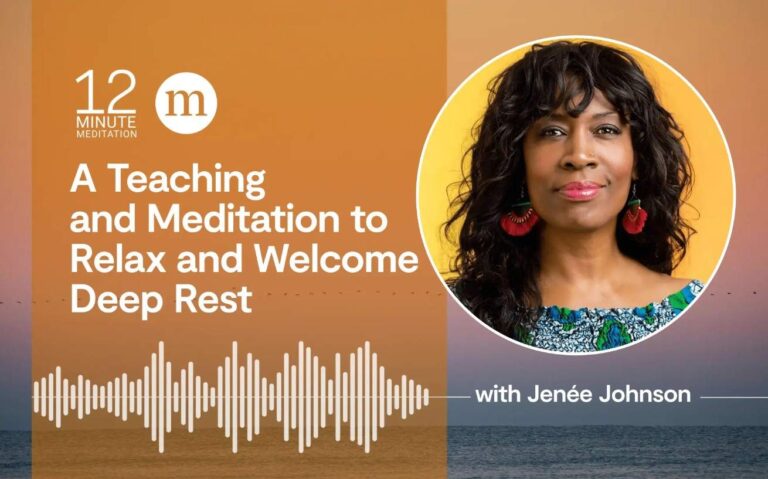“`html
In today’s discussion, Jenee Johnson takes us through an exploration of the reasons behind deep relaxation techniques and how to practice them, along with a meditation that you can do whenever you’d like.
Rest is not just a reward for hard work; it’s a fundamental human necessity and a right.
This week’s segment is somewhat unique. We are not only offering a guided meditation led by mindfulness expert Jenée Johnson, but we’ll also delve into the science of relaxation—covering its importance for our health, how it functions, and tips for integrating purposeful relaxation practices into our everyday routines.
Jenée Johnson is the founder of the Right Within Experience, where she fosters a sense of inner tranquility, resilience, self-acceptance, and joy through meditation and mindfulness techniques, particularly for individuals of African heritage. She has also served as the program innovation leader at the San Francisco Department of Public Health, focusing on Mindfulness, Trauma, and Racial Healing.
A Method and Meditation for Embracing Deep Rest
Throughout our day, our body gives us signals that it’s time to relax—to pause from activity, to sit in silence, and to transition from noise to quiet. Our minds and bodies require moments of stillness, moments away from agitation, planning, and even celebrations.
Factors like stress, trauma, and tension impact our capacity to unwind. Therefore, performing daily “relaxation activities” is crucial to mitigate the adverse effects of stress on our bodies. As stated by Dr. Frank Staggers Jr., those who engage in daily relaxation routines enjoy better health, increased energy, and clearer thinking. This underscores the necessity of setting aside 20 minutes, once or twice a day, for profound relaxation.
A great technique for achieving deep relaxation is called quiet sitting or free-floating relaxation. In this practice, you sit quietly for about 20 minutes, letting your mind drift until it calms down. There’s no need to focus on anything specific—just allow your mind and body to find their own state of stillness.
A great technique for achieving deep relaxation is called quiet sitting or free-floating relaxation. In this practice, you sit quietly for about 20 minutes, letting your mind drift until it calms down.
For deep relaxation to occur, it’s important to let thoughts come and go naturally. While you are relaxing, various thoughts may cross your mind. That’s perfectly normal. Don’t stress about these thoughts; don’t try to push them away or dwell on them. Simply let them pass by, and over time, they will recede into the background, allowing you to continue to relax.
The scientific term for a profound state of alert relaxation is the alpha state. This occurs when the brain calms down and produces steady, smooth waves known as alpha brain waves. These waves have a frequency of eight to 12 cycles per second, in contrast to faster excitement or arousal waves, termed beta brain waves, which range from 13 to 40 cycles per second. Achieving the alpha state is linked with total relaxation throughout the body and a healthy reduction in metabolism.
Activities like watching television, listening to music, reading, sewing, or fishing don’t typically reach the alpha deep relaxation level, as they still require mental engagement. While these activities may help you feel somewhat relaxed, they won’t lead you into deeper states of relaxation. Moreover, even sleep doesn’t achieve this level of complete relaxation, as the brain remains active, especially during dreams.
Even after sleep, you can still feel stressed. That’s where relaxation practices come in, enabling your mind and body to reach deeper relaxation.
While sleep is vital for various other functions, it does not fully relax the brain or alleviate stress. You might still feel stressed post-sleep. Relaxation drills help your mind and body access deep relaxation states. So, let’s take a moment to practice together.
Follow the guided meditation script below, pausing as needed after each paragraph. Alternatively, listen to the audio practice.
- Sit comfortably in an upright position, either lowering your gaze or closing your eyes. Inhale deeply, then exhale audibly. As you breathe in and out, invite your body to relax.
- As we sit and breathe, we trigger the body’s calming response. It helps the brain produce calm, smooth, harmonious waves called alpha brain waves—similar to ocean waves that tide in and out. Breathe in and breathe out. Relax.
- Relax your shoulders, loosen your jaw, and smooth your forehead. Let your mind wander until it finds calm. Allow thoughts to come and go freely.
- Gently return your focus to your breath. Don’t stress about blocking thoughts. Just stay relaxed and remind yourself that you’re sitting, breathing, and relaxing. Sit quietly and focus on your breath, like the ebb and flow of the ocean. Let thoughts settle into the background. Relax, enjoy stillness, peace, and ease. This is the essence of relaxation.
“`


